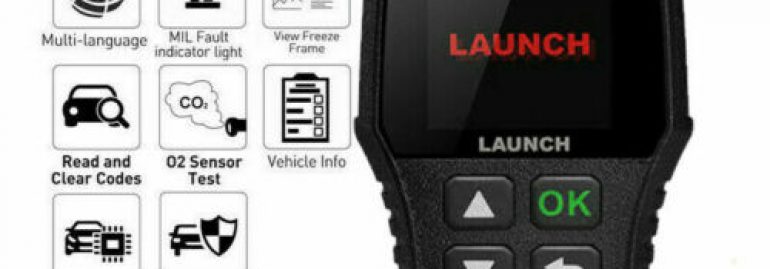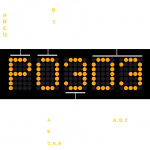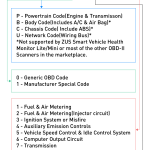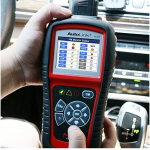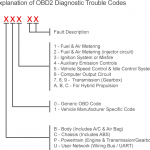A car scanner code can help you diagnose the condition of your vehicle. The most common problems that can be solved with a scanner include engine trouble, fuel system problem, and more. You can read trouble codes, diagnose the problem, and perform a diagnostic procedure. This article will introduce you to a car scanner code and its uses. It also includes the meaning of the trouble codes and how to read them. Before you purchase a car scanner, be sure to read the manual carefully.
OBD-II codes
If you have a car, you have probably used an OBD-II code reader at some point. These devices interpret the information from your car’s engine and can help you identify the exact problem. An OBD reader can also be useful if you have a Bluetooth-enabled smartphone. An OBD-II code reader can display the codes and explain their meaning. If you are a mechanic, it can be very helpful to know the information and be able to repair it in time.
First, you need to know your car’s model and make. You will need the VIN to find the OBD-II port. Usually, this port is located beneath the dashboard. Sometimes, it is located in areas four to nine, such as the steering column. Regardless of where you install the OBD-II scanner, you will need to know the make and model of your car. The software will prompt you to enter these two pieces of information. The VIN is usually located on the metal tag near the base of the driver’s side windshield. It is easiest to read this information from outside the car.
OBD-II codes are usually grouped into categories, including generic codes, manufacturer-specific codes, and vehicle-specific codes. Global codes, for example, are used by most cars that adhere to the OBD2 standard. These codes are often assigned a generic fault message. Manufacturer-specific codes, on the other hand, are specific to the car model. You can learn more about each type of code and what it means in the manufacturer’s manual.
Using an OBD-II car scanner is a good idea when your vehicle has a check engine light. If it is illuminated, it means your car has a problem. This code may be caused by a faulty gas cap or a loose wire. However, if you ignore the warning, you may end up with a costly repair job. You need a scanner that can accurately diagnose the problems.
OBD-II codes for car scanners have become commonplace. California made it mandatory for all cars to have an interface by the beginning of the 1990s. Using an OBD-II code scanner is easy because you can purchase a standardized connector, which makes the cost of scanners much cheaper. No longer do you need to spend thousands on expensive scanners that require updates. These tools allow you to easily review the data from your car’s computer.
Diagnostic trouble codes
The check engine light on your car may be a symptom of an underlying problem with the car’s engine. The light indicates that something is wrong with the car’s engine management system, or another function. Identifying the problem requires using a car scanner that reads Diagnostic Trouble Codes, or DTCs. DTCs are five-digit codes that are associated with a particular car issue. These codes will appear on the scanning tool when it’s connected to the car’s OBD system. Each DTC will represent a unique problem.
To read diagnostic trouble codes, you should connect a code reader to your vehicle’s ignition or engine. It must be compatible with your vehicle’s electronic control unit (ECU). Most code readers will ask for some type of information, such as the vehicle’s year and model. The scan tool will then display a list of DTC fault codes and their definitions. While reading the codes, make sure to write down the code definitions so you know what to do when the problem returns.
If you get a lot of DTCs, you should always start by addressing the most critical ones first. While the error codes are easy to read, they may not be accurate. If you read them wrong, you might even end up with an inaccurate diagnosis. In this case, you may want to consult your car’s manual to determine which problem code to look for. Once you’ve determined which trouble codes are present, you’ll be able to determine the cause of the problem and repair or replace it as necessary.
If you don’t have a scanner, you can purchase an OBD-II scanner. OBD codes are the simplest to read, as they are found in any modern vehicle. You can also select a car code reader with a data link connector, which can be used with OBD-II diagnostics. It’s important to remember that these codes have a different meaning for each make and model of car.
Meaning of trouble codes
Diagnostic trouble codes are digits that indicate problems with a car or truck’s electronic systems. These codes can be categorized according to what type of vehicle they are from. The first digit of the trouble code indicates if it’s generic or model specific. A second digit indicates whether the trouble code is associated with a specific problem. If the trouble code has three digits or more, it’s a problem with the drivetrain or the engine.
EVAP codes indicate whether there’s an issue with your vehicle’s EVAP system, which prevents exhaust fumes from entering the air to help keep air pollution to a minimum. Transmission codes, which monitor the transmission, are typically triggered by malfunctions within the vehicle’s computer system. Regardless of what type of on-board malfunction you’re experiencing, it’s important to use the appropriate diagnostic tools to determine the cause.
The first step is to understand what the codes mean. Typically, a DTC code will contain a two-digit code (DTC), and the number should be between 0 and 99. Generally, the first digit is the generic code, while the second digit is the specific problem. If you’re unsure, consult your car’s manual or the manufacturer to learn more about the trouble codes. But for the most part, they can tell you if your car needs a tune-up.
Using an OBD scanner is a great way to get diagnostic information on your car’s OBD system. This system records trouble codes that are unique to your vehicle, such as P0201. A P0201 trouble code, for example, means a problem with the cylinder one injector circuit. An OBD2 code is usually a P0100 code. When the code indicates a malfunction in a car, you can use a code reader to fix it.
A diagnostic trouble code is a number that the on-board computer management system in a vehicle records when something malfunctions. These codes are also known as DTCs (Diagnostic Trouble Codes) or OBD-II codes. By reading these codes, you can determine which system is malfunctioning. This is how the trouble is detected. The vehicle’s computer will activate a trouble code when it needs to be fixed.
How to read trouble codes
There are many ways to read car scanner trouble codes. You can use the scan tool’s READ CODES button or option on the tool menu. Some scanners will ask you to input information about your vehicle before displaying the diagnostic fault codes. To get the most out of your scan tool, you should write down the codes and the description for each one. Then, you can refer to these codes later. Depending on the tool, you may need to use a dictionary to read the trouble codes.
When your car starts to emit a DTC, the engine light will flash. The DTC indicates a malfunction with the emission control system. This code is the same one you see on your dashboard when you push the Start/Stop button. If you are experiencing any of the symptoms listed above, it’s time to get a scanner and diagnose the problem. However, if you have a car that doesn’t show this code on its dash, your next best step is to consult a mechanic for further assistance.
There are three main categories of DTCs: chassis (C-codes) and body (B-codes). The first one pertains to the engine and is the most important. The other two relate to the chassis and body systems. The last category relates to the network and vehicle integration systems. The first digit of a trouble code will tell you whether it is generic or manufacturer-specific. This will determine the type of DTC to be read.
If you have trouble detecting the trouble codes on your car, the first step is to understand what the codes mean. Trouble codes are unique numbers assigned to each problem. You can check the codes with the help of these codes. If you don’t understand them, consult with a mechanic or a technician. You’ll be able to identify the trouble with your car much easier this way. So, how to read car scanner trouble codes and diagnose the problem correctly?
The first step to read car scanner trouble codes is to understand the code that your car shows on its dashboard. The light on your dashboard is often referred to as the check engine light, or OBD. When it flashes, the problem may be an electrical problem. The OBD code contains information about the problem. It will tell you whether your car is running fine or needs to be diagnosed. A malfunction in the OBD system can lead to a car malfunction or other problem.


